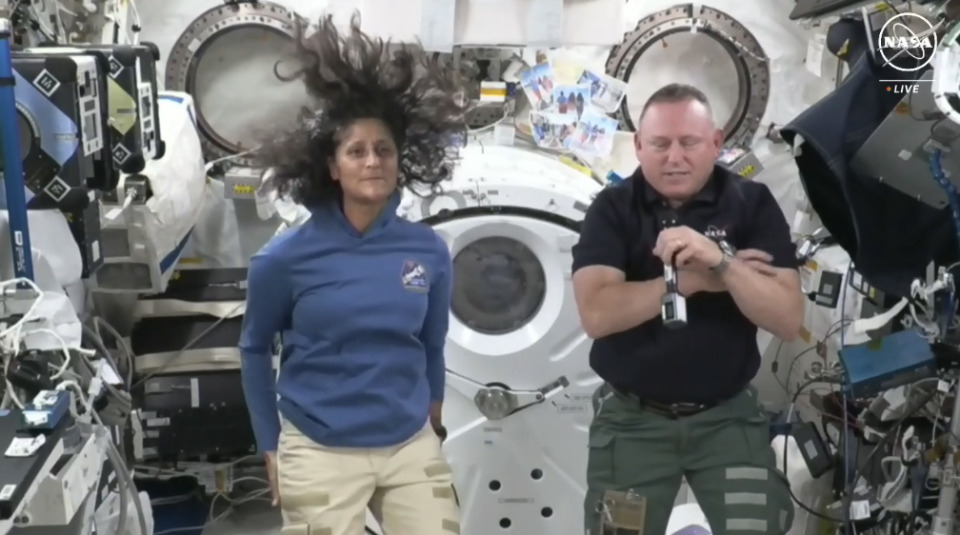NASA: Starliner astronauts not stranded in space, but more testing sought before return
- Oops!Something went wrong.Please try again later.
- Oops!Something went wrong.Please try again later.
The two NASA astronauts who flew Boeing's Starliner to the International Space Station on its first crewed test flight more than three weeks ago still don't have a return-to-Earth date, but NASA and Boeing officials repeated — with some aggravation — that the crew is neither stuck in space nor in any danger.
The delay in the return of Suni Williams and Butch Wilmore, officials said at a Friday news conference, gives NASA and Boeing teams an opportunity to better understand the issues that arose with Starliner, both a helium leak that initially delayed launch and thruster problems on the service module.
A thruster test is planned at NASA's White Sands Test Facility that Ken Bowersox, associate administrator of NASA’s Space Operations Mission Directorate, said could take a couple weeks. The analysis of that data will help officials decide what's next.
"Butch and Suni are not stranded in space," said Steve Stich, manager of NASA's Commercial Crew Program. "Our plan is to continue to return them on Starliner and return them home on the right time ... We have a little more work to do to get them there."
Next launch Is there a launch today? Upcoming SpaceX, NASA, ULA rocket launch schedule in Florida
Starliner launched from Cape Canaveral on an Atlas V rocket on June 6 and arrived at the space station for what initially was planned as an eight-day flight.
Mark Nappi, vice president and program manager of Boeing's Commercial Crew Program, said it was frustrating to see headlines that talked about the crew being stuck as well as criticism of Starliner's safety. NASA officials noted that on Wednesday, the space station faced an unexpected orbital debris issue from the breakup of a decommissioned satellite. Wilmore and Williams were prepared to use the Starliner as a space "lifeboat" if needed (it was not needed, ultimately) — and NASA was comfortable with that.

"We understand these issues for a safe return," Nappi said. "What we don’t understand enough yet is (how) to fix them permanently."
"It would be irresponsible for us if we have time and we want to do more, not to do it," Nappi added.
NASA's Bowersox was a little more cautious, saying while they'd feel confident returning a crew on Starliner in the case of a space station emergency, for a normal, non-emergency return, they'd like more data first.
The helium leak was discovered after the first launch scrub in May, and it expanded after launch. No helium is leaking now while the Starliner is docked to the station, and Stich said they continue to "verify helium margins and double check those."
"Nothing has changed with the leak rates, we need about seven hours of helium to undock and get to deorbit burn," he said. "We have 10 times that margin."
The problematic thrusters were put through a test on the station and performed well, and now the White Sands test will help gather additional data. Nappi said teams lay out what they call a "fault tree" and it includes dozens of boxes of potential causes that they work to eliminate in the hunt for the root cause. When that's found, they'll attempt to solve it.
As the crew's stay on the orbiting outpost lengthens, NASA teams said the astronauts' families were being kept informed, and both astronauts were able to make daily phone calls home.
NASA originally awarded Boeing the contract to fly astronauts in 2014, alongside SpaceX. Boeing received $4.8 billion for Starliner while SpaceX received $3.1 billion for Dragon. Both companies were part of NASA's Commercial Crew Program, which replaced the space shuttle after its retirement in 2011.
Both were late to deliver, hoping to launch as soon as 2017 and restore NASA astronauts access to space from American soil (NASA astronauts were hitching rides aboard the Russian Soyuz).
Following a successful crewed demo flight in 2020, SpaceX has since flown eight NASA crews and multiple private crews to the ISS. Boeing's Starliner had faced repeated delays even getting to its first crewed flight this month.
Asked if there was any chance that Williams and Wilmore would not be able to return on the Starliner, NASA officials said the plan was to return on Starliner but noted that they have the luxury of other spacecraft on the station if needed. Right now, the station has a SpaceX Dragon and a Russian Soyuz docked to it.
"Right now, we are focused on returning Butch and Suni on Starliner," Stich said.
This article originally appeared on Florida Today: Starliner astronauts "not stranded in space," new spacecraft tests planned

